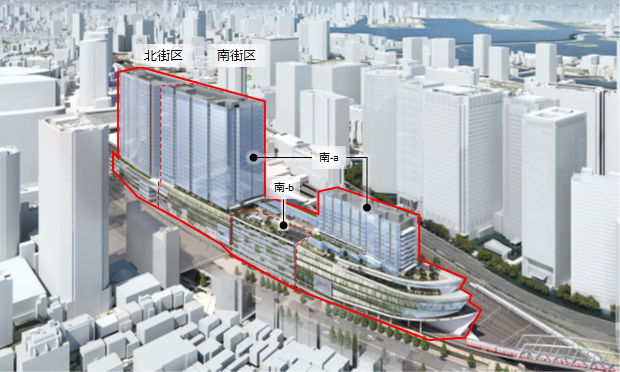Many people considering real estate investment may be concerned that the initial cost of apartment or condominium management is too high, or that management may be difficult. For such people, we recommend investing in parking lots.
Compared to other real estate investments, parking lot investment can significantly reduce initial costs and requires less management effort, making it an easy investment to start even for beginners in real estate investment. In fact, real yields of around 4% for monthly parking lots and 15-30% for coin-operated parking lots can be highly profitable.
In this article, INA & Associates, Inc. will explain in detail the specific merits of parking lot investment, the market rate of yield, initial costs, and the key to success. This information will be useful for those who want to start investing in real estate or add a new option to their existing investment portfolio.
Basic Knowledge and Types of Parking Lot Investments
Before getting started with parking lot investing, it is important to first understand the basic structure and types of parking lot investments. There are two main types of parking lot investments: monthly parking andcoin-operated parking, each with different characteristics and profit structures.
What is monthly parking?
Monthly parking facilities are operated by entering into a monthly contract with a user and providing parking space for a fixed monthly fee. The most important feature of this method is that it provides a stable income during the contract period. Once a contract is concluded, a fixed amount of income can be expected each month, making it easy to forecast earnings and to plan financial resources.
Users of monthly parking lots are mainly neighborhood residents and commuters, and are expected to use the facilities for a long period of time. For this reason, residential areas, areas near train stations, and office districts are suitable locations, and can meet the needs of people who require parking on a daily basis.
What is coin parking?
Coin-operated parking is a method of operation in which parking fees are collected on an hourly basis. Users use the parking lot for the amount of time they need and pay a fee each time. This method is characterized by the fact that the frequency of use fluctuates greatly depending on the location and time of day, so revenues are likely to fluctuate as well.
The profitability of coin-operated parking depends largely on the location and turnover rate. While high profitability can be expected in locations with high foot traffic, such as commercial facilities, hospitals, and station areas, it may be difficult to generate the desired profitability in locations with low demand.
Choice of Management Method
There are two types of management methods for parking lot investment: self-management, in which the land owner directly manages the parking lot, and lump-sum leasing, in which the management is outsourced to a specialized contractor.
In the self-management method, the land owner handles everything from capital investment to daily management. This method has the potential to be more profitable, but requires more time and effort for management and a larger initial investment.
On the other hand, in the lump-sum lease method, a specialized company leases the land and operates the parking lot, while the landowner pays a fixed rent. This method is less profitable than the self-management method, but it requires less management effort and provides a stable income.
Seven Advantages of Parking Lot Investment
Parking lot investment has attracted the attention of many investors because of its unique advantages not found in other real estate investments. Here we will explain in detail the seven main advantages of parking lot investment.
1. Low initial cost
One of the greatest advantages of parking lot investing is the ability to significantly reduce initial costs. While apartment and condominium management requires initial investments ranging from tens to hundreds of millions of yen, in some cases, parking lot investment can be started from zero yen for a monthly parking lot.
Let's take a look at a comparison of specific initial costs.
Type of investment Approximate initial cost Main expense items
Apartment management 30-100 million yen Construction, design, and various procedural fees
Condominium management 20-80 million yen Property purchase cost, remodeling costs
Monthly parking lot 0-5 million yen Land preparation, plot line drawing, signboard installation
Coin-operated parking ¥2-10 million Equipment, land preparation, system installation costs
For monthly parking lots, if the land is already flat, operation can be started simply by drawing demarcation lines and installing signboards. Even if land preparation is required, the cost is much less than constructing a building.
Coin-operated parking requires an initial investment in a payment machine and gate equipment, but even so, it can be started with less than one-tenth of the capital required for apartment management. This low barrier to entry makes it easy for even beginners in real estate investment to get started.
2. Narrow or deformed lots can also be utilized.
One of the major attractions of investing in parking lots is the flexibility of not having to choose the shape or size of the lot. When constructing apartments or condominiums, the Building Standards Law and the Urban Planning Law restrict construction only on land that meets certain conditions.
However, parking lots can make effective use of the following types of land
- Narrow lots: Can be operated as long as there is space for one car.
- Deformed land: Triangular, trapezoidal, or other irregularly shaped land
- Land with a difference in elevation: Can be used even if there is a slight incline
- Land with poor road access: Unsuitable for construction, but no problem for parking
Especially in urban areas, there are many small or deformed lots that are not suitable for building. Since such land is generally priced at a low level, high yields can be realized if purchased as land for parking lot investment.
3. Short preparation period
Parking lot investment has the great advantage of being able to start operations in a short period of time. While apartment and condominium management typically takes a year or more from planning to completion, parking lot investment can begin operations in a matter of weeks or months.
A comparison of preparation periods is shown below.
Type of investment Preparation period Major tasks
Apartment management 12-18 months Design, application for building permit, construction
Apartment management 6-12 months Property selection, financing procedures, renovation
Monthly parking 2 weeks to 2 months Land preparation, plot line drawing, signboard installation
Coin-operated parking: 1-3 months Installation of equipment, system installation, various procedures
This short preparation period allows the company to respond quickly to changes in the market. For example, if a new commercial facility is scheduled to open in the neighborhood, a high profit can be expected by opening a parking lot in a timely manner to coincide with its opening.
4. Less management effort
Another major advantage of investing in a parking lot is that it requires less daily management work. Apartment and condominium management involves a wide range of management tasks, such as dealing with tenants, facility maintenance, and cleaning.
The management tasks of parking lot investment are mainly limited to the following
Monthly parking lot management
- Contractor management
- Collection of monthly fees
- Periodic cleaning
- Handling of unapproved parking
Management of coin-operated parking
- Cash collection from payment machines
- Inspection and maintenance of facilities
- Cleaning duties
- Trouble handling
Especially when the bulk leasing method is selected, the landowner does not need to do anything as all these management tasks are handled by a professional contractor. Even those who are busy with their day jobs or live far away can invest with peace of mind.
5. Easy conversion to other uses
One of the key advantages of investing in parking lots is the ease with which they can be converted to other uses in the future. When an apartment or condominium is built, demolition costs a large amount of money and conversion to other uses is difficult.
However, with a parking lot, the following conversions are relatively easy
- Residential construction: use as cleared land
- Commercial facilities: Build a store if the location is suitable.
- Other investment properties: construction of condominiums or apartments
- Sale: Can be sold as cleared land at a higher price
This flexibility allows for the selection of the most appropriate land use method in response to changes in the market environment and individual investment strategies. For example, a strategy of operating the property as a parking lot while waiting for land prices to rise and selling it at the appropriate time is possible.
6. Stable profitability
Parking lot investment is an investment technique that can be expected to generate stable income if the appropriate location is selected. In particular, once a contract is concluded for a monthly parking lot, you can expect a stable income for a long period of time.
The following factors support the stability of earnings from parking lot investment.
Stable demand
- The number of automobiles owned remains at a certain level
- Chronic shortage of parking in urban areas
- Continued parking demand from residents in residential areas
Barriers to entry for competitors
- Suitably located lots are limited
- Existing parking users tend to be reluctant to move
- Community-based business characteristics
Resilience to economic environment
- Less susceptible to economic fluctuations
- Demand for parking as a daily necessity
- Few sudden fluctuations in rent levels
7. Flexibility to choose any location
Parking lot investment is characterized by the possibility of success in a wide variety of locations. While apartment and condominium management cannot expect high returns unless the property is in a good location, such as near a train station or commercial facilities, there are many examples of successful parking lot investment in a variety of locations.
Successful Patterns in Residential Areas
- Monthly parking in areas with many detached houses
- Additional parking for condominium residents
- Demand for visitor parking
Successful patterns in commercial areas
- Coin-operated parking for retail users
- Revenue from high turnover of short-time use
- Special rates for events
Successful pattern in office districts
- Monthly parking for commuters
- Parking demand for business vehicles
- Stable utilization rate on weekdays
Successful pattern in suburbs
- Demand near large commercial facilities
- Seasonal demand near tourist attractions and leisure facilities
- High yield due to low-cost land acquisition
As described above, parking lot investment can generate income in a variety of areas by selecting an operating method that is appropriate to the characteristics of the location.
Yield and Profitability of Parking Lot Investment
One of the most important indicators when considering a parking lot investment is the yield. Yield is an important indicator for measuring investment efficiency and is also essential for comparison with other investment methods. Here, we will explain in detail the yield rate and profitability of parking lot investment.
Basic Knowledge of Yield
There are two types of yields : surface yield andreal yield. When making investment decisions, it is important to focus on real yields that are closer to actual conditions.
Surface Yield (Gross Yield)
Surface yield = Annual income ÷ Total investment × 100
Real Yield (Net Yield)
Real Yield = (Annual Income - Annual Expenses) ÷ Total Investment × 100
The real yield is calculated by subtracting expenses such as management fees, taxes, insurance premiums, and repair costs, thus providing a more realistic picture of profitability.
Monthly Parking Lot Yield Rates
The standard realistic yield for a monthly parking lot is around 4%. However, it is important to consider individual conditions in detail, as they vary greatly depending on the location and management system.
Location Conditions Surface Yield Real Yield Approximate Monthly Rent (1 car)
Urban area (within 5 minutes' walk of station) 6-10% 4-7% 25,000-40,000 yen
Residential area (within 10 minutes' walk of station) 8-12% 5-8% 15,000-25,000 yen
Suburban area (more than 15 min. walk from station) 10-15% 6-10% 8,000-15,000 yen
The points to improve profitability of monthly parking are as follows.
Points to improve profitability
- Maintain full occupancy rate: Minimize empty periods.
- Setting appropriate rents: Competitive prices based on the surrounding market
- Promoting long-term contracts: Initiatives to increase the contract renewal rate
- Cost optimization: Reduce unnecessary costs
Coin-operated parking yield rates
While coin parking can expect higher yields than monthly parking, earnings fluctuate greatly depending on the location and management method. The market rate of surface yield is 15-30%, but for the real yield, capital investment and operating costs must be taken into account.
Location Surface Yield Real Yield Approximate Hourly Rate
Commercial area, in front of station 20-35% 12-20% 300-600 yen/hour
Office area 15~25% 8~15% 200~400 yen/hour
Residential area 10~20% 5~12% 100~300 yen/hour
The revenue of coin-operated parking is highly dependent on the turnover rate; the more cars per day, the higher revenue can be expected.
Simulation of revenue based on turnover rate (in the case of a parking lot accommodating 10 cars)
Turnover rate Number of cars used per day Average usage time Approximate daily revenue Approximate monthly revenue
Low turnover (1.0 turnover) 10 units 2 hours 6,000 yen 180,000 yen
Medium turnover (2.0 turnover) 20 units 2 hours 12,000 yen 360,000 yen
High turnover (3.0 turnover) 30 units, 2 hours, 18,000 yen, 540,000 yen
Comparison of profitability with other real estate investments
To properly evaluate the profitability of parking lot investment, let's compare it with other real estate investments.
Type of investment Surface yield Real yield Initial cost Management effort
Condominiums 4-8% 2-5% High Medium
Single-unit apartments 6-12% 4-8% High High
Detached house rental 8-15% 5-10% Medium Medium
Monthly parking 5-15% 4-10% Low Low
Coin-operated parking 15-30% 8-20% Medium Low
As this comparison shows, parking lot investments have an advantage in terms of low initial costs and low management effort. It is an attractive option, especially for beginner investors, who can gain experience in real estate investment while minimizing risk.
Factors Affecting Profitability
The profitability of parking lot investments depends largely on the following factors
Location factors
- Distance from train station
- Density of nearby commercial and residential properties
- Accessibility from the street
- Availability of competing parking facilities
Operational Factors
- Adequacy of rate setting
- Adequacy of management system
- Adequacy of facilities
- Marketing activities
External factors
- Local demographics
- Changes in the economic environment
- Availability of transportation infrastructure
- Changes in urban planning
The key to success in parking lot investment is to comprehensively consider these factors and develop an optimal investment strategy.
Initial Costs and Risks of Parking Lot Investment
Before starting a parking lot investment, it is important to properly understand the initial costs required and potential risks. Proper financial planning and risk management will ensure stable investment results.
Detailed Breakdown of Initial Costs
The initial cost of a parking lot investment varies greatly depending on the operating method and land conditions. Here is a detailed breakdown of each case.
Initial Cost of Monthly Parking
Monthly parking is the most cost-effective form of parking lot investment.
Cost Item Approximate Amount Remarks
Land preparation cost 500,000 yen ~ 2,000,000 yen, varies depending on land conditions
50,000-150,000 yen (varies depending on the number of vehicles)
Signboard installation 100,000-300,000 yen, varies depending on size and material
Lighting facilities: 200,000 yen to 500,000 yen, depending on need
Security equipment: ¥100,000 - ¥400,000 Security cameras, etc.
Various procedural fees 50,000 yen to 100,000 yen Procedures for notification, etc.
Total 1,000,000 yen to 3,450,000 yen for 10 cars
If the land is already flat and well-developed, operations can begin with only drawing a demarcation line and installing signboards, so it is possible to start with as little as 200,000 yen.
Initial Cost of Coin-operated Parking
The initial cost of coin parking is higher than that of monthly parking because of the capital investment required.
Cost Item Approximate Amount Remarks
Land preparation cost 500,000 yen ~ 2,000,000 yen, depending on land conditions
Settlement machine installation 1.5-3 million yen Price difference depending on function
Gate equipment 1,000,000 yen ~ 2,000,000 yen, varies depending on the number of gates
Drawing of demarcation lines 100,000-200,000 yen, price varies depending on the number of units
Signboards and lighting: 300,000-800,000 yen, varies depending on the scale
Security equipment 200,000-600,000 yen Cameras, sensors, etc.
System installation cost ¥500,000-1,000,000 Management system
Various procedure fees 100,000 yen - 200,000 yen Notification and other procedures
Total 4,200,000 yen to 9,800,000 yen for 10 units
Initial cost of lump-sum lease
The lump-sum lease method, in which management is outsourced to a specialized contractor, significantly reduces the initial cost burden.
Operation method Initial cost burden Profit sharing
Self-operated method: 100% of initial cost 100% of revenue
Lump-sum lease method: Contractor pays 60-80% of revenues
Outsourced management method Partly self-financed 85-95% of revenues
Major Risks of Parking Lot Investment
Although parking lot investment is a relatively low-risk investment technique, it is important to understand that the following risks exist.
1. Demand fluctuation risk
Risks include
- Decrease in parking demand due to changes in the surrounding environment
- Outflow of users due to the establishment of new competing parking facilities
- Decrease in automobile use due to population decline or aging population
Countermeasures
- Detailed survey of the surrounding environment at the time of site selection
- Selection of locations with multiple sources of demand
- Maintain competitiveness through flexible rate setting
2. Risk of revenue fluctuation
Details of risk
- Fluctuations in usage due to seasonal and day-of-week changes
- Changes in frequency of use due to changes in economic conditions
- Decline in profitability due to rate competition
Countermeasures
- Combination of monthly and coin-operated parking
- Set appropriate rates and review them periodically
- Stabilize revenue by promoting long-term contracts
3. Facility and management risk
Description of risks
- Failure of payment machines or gate equipment
- Occurrence of unauthorized parking and nonpayment of fees
- Renewal costs due to aging facilities
Countermeasures
- Regular maintenance of equipment
- Implementation of appropriate security measures
- Hedge risks through the use of insurance
4. Legal and tax risks
Details of Risks
- Land use restrictions due to changes in urban planning
- Increased tax burden
- Trouble with neighbors
Countermeasures
- Thorough legal research in advance
- Cooperation with tax specialists
- Consideration and appropriate communication with neighbors
Specific Measures to Mitigate Risk
The following measures are recommended to minimize the risks of parking lot investments.
Points to consider when selecting a location
Survey items for the surrounding environment
- Demographics and future projections
- Traffic volume and traffic patterns
- Status of competing parking facilities
- Future development plans
Demand Survey Methodology
- Parking demand survey by time of day
- Interviews with nearby residents and businesses
- Analysis of best practices in similar locations
Selection Criteria for Operation Method
Selection Criteria Self-operated Type Lump-sum lease
Initial investment Large Small
Profitability High Moderate
Management effort
Risk High Low
Applicable situation Experienced investors Beginners and busy people
Use of Insurance
It is important to consider the following types of insurance for parking lot investments.
Recommended Types of Insurance
- Facility liability insurance: coverage for accidents in the parking facility
- Comprehensive movable insurance: Coverage for theft or damage to equipment
- Compensation for absence from work insurance: Compensation for earnings in the event of absence from work due to equipment breakdown, etc.
Tax Considerations
It is important to understand the tax treatment of parking lot investments.
Income Tax Treatment
Parking lot income is taxed as real estate income. However, the following expenses can be deducted.
Items allowed as necessary expenses
- Depreciation of land and buildings
- Repair and maintenance expenses
- Nonlife insurance premiums
- Taxes and dues (property tax, etc.)
- Interest on loans
Inheritance tax treatment
Since land for parking lots is valued as cleared land, the effect of inheritance tax reduction is limited compared to land for rental housing. When focusing on inheritance measures, it is important to include future land utilization methods.
The key to success in parking lot investment is to fully understand these risks and countermeasures before making an appropriate investment decision.
Key to Successful Parking Lot Investment
A strategic approach is necessary to generate stable income from parking lot investments. Here, we will explain in detail the key points for success based on our actual investment experience.
The Importance of Location Selection
It is no exaggeration to say that 80% of a successful parking lot investment is determined by location selection. By selecting the right location, you can ensure stable earnings over the long term.
Requirements for Excellent Locations
Excellent location in a residential area
- Densely populated residential area within a 10-minute walk from a station
- Areas with many detached houses and properties that do not come with parking lots
- Around newly constructed condominiums that are scheduled to be built
- Close to commercial facilities, hospitals, schools, and other convenient living facilities
Excellent location in a commercial area
- Areas with high pedestrian traffic, such as in front of stations and downtown areas
- Areas with a high concentration of commercial facilities and restaurants
- Around event venues and tourist attractions
- Areas with high occupancy rates for existing parking lots
Excellent locations in office districts
- Areas with a high concentration of businesses and government offices
- Areas with limited public transportation access
- Locations where parking demand for business vehicles can be expected
- Locations where stable weekday demand can be expected
Specific Methods of Location Survey
Checkpoints of the site survey
Survey items to be checked Survey time zone
Traffic volume Pedestrian and vehicle traffic volume Weekday and holiday hours
Competition Rates and occupancy rates of nearby parking lots Multiple site visits
Demand source Distribution of residences, commercial facilities, and offices Within a radius of 500 m
Access Road width and ease of entry Confirmation by actual driving
Location evaluation by data analysis
- Analysis of demographics and future projections
- Trends in automobile ownership
- Survey of nearby development plans
- Identification of land price trends
Strategies for Selecting an Operation Method
In parking lot investment, it is important to select the most appropriate management method according to the investor's experience, financial resources, and investment goals.
Advantages and disadvantages of the self-management method
Advantages
- 100% revenue can be secured.
- Freedom to set fees and operational policies
- Quick response to market changes
- High profitability can be expected in the long term
Disadvantages
- Large initial investment
- Daily management work is required
- Risk of equipment failure, etc.
- Requires specialized knowledge
Applicable Situations
- Experienced real estate investors
- Those who can secure sufficient initial capital
- Those who want to be actively involved in the business
Advantages and disadvantages of the lump-sum lease method
Advantages
- Initial investment can be reduced.
- Management can be outsourced to specialized companies
- Stable income can be secured
- Less risk of equipment failure, etc.
Demerit
- Lower profitability than self-management
- Cannot be involved in management policy
- There is a risk of changes in contract conditions
- Depends on the business conditions of the contractor
Applicable Situations
- Beginners in real estate investment
- Those who are too busy with their day job to devote time to management
- Those who want to minimize risk
Strategies for setting rates
Setting appropriate rates is an important factor that greatly affects the profitability of parking lot investment.
Setting Monthly Parking Lot Rates
Grasping the appropriate price through market research
Survey subject Survey content Importance
Direct competition Monthly parking fees in the same area High
Indirect competition Parking fees in neighboring areas Medium
Alternatives Cost of using public transportation Medium
Demand User willingness to pay price High
Basic principle of rate setting
- Differentiate by setting prices slightly lower than competitors
- Appropriate pricing based on convenience of location
- Introduce a discount system for long-term subscribers
- Conduct periodic rate reviews
Setting rates for coin-operated parking
Concept of setting rates by time zone
Time of day Rate setting concept Rate example
Weekday daytime Standard rate in line with surrounding market rate 200 yen/hour
Weekday nighttime Discounted rate based on demand 100 yen/hour
Holiday daytime: Surcharge 300 yen/hour if demand is high
Max. charge Securing long-time users 1,000 yen/day
Use of dynamic rate setting
- Special rates for events
- Rate adjustment based on seasonal fluctuations
- Rate optimization based on occupancy rates
- Quick response to changes in competitive conditions
Customer Attraction and Marketing Strategies
An effective customer attraction strategy is essential to the success of your parking investment.
Utilize online customer attraction
Disseminate information on the website
- Detailed information and photos of parking facilities
- Provide information on access and nearby facilities
- Clear explanation of fee structure and usage
- Establishment of an inquiry form
Registration on parking lot search sites
- Registration of information on major parking search sites
- Management and improvement of user reviews
- Consider introducing a reservation system
- Improvement of search rankings through SEO measures
Importance of attracting offline customers
Signage and signage planning
- Installation of highly visible signage
- Easy-to-understand price listings
- Clear guidance on how to use the facility
- Improved nighttime lighting
Community-based sales activities
- Greetings and explanations to neighbors
- Cooperation with local real estate agencies
- Consider partnerships with commercial facilities
- Promotion of referrals by word of mouth
Long-term investment strategy
In order to make a successful parking lot investment, it is important to develop a strategy from a long-term perspective, not just short-term earnings.
Consideration of exit strategies
Criteria for determining when to sell
- Securing profit from sales due to rising land prices
- Decrease in demand due to changes in the surrounding environment
- Emergence of more profitable investment opportunities
- Recombination of assets as an inheritance measure
Consideration of land use conversion
- Possibility of conversion to rental housing
- Consideration of commercial facility development
- Sale to other investors
- Conversion to personal use
Portfolio construction
Risk mitigation through diversification
Perspective of diversification Specific method Effect
Regional diversification Investment in multiple areas Reduction of regional risk
Diversification of use Combination of monthly and coin-operated use Equalization of revenue fluctuation
Scale diversification Investment in various sizes Optimization of investment efficiency
Timing diversification Phased investment execution Reduction of market fluctuation risk
Growth strategy planning
- Horizontal deployment of best practices
- Efficiency through expansion of scale
- Differentiation through increased expertise
- Leverage partnerships
By comprehensively implementing these points, the probability of success in parking lot investment can be greatly improved. We recommend that beginners in particular start with a small investment to gain experience, and then gradually expand the scale of their investment.
Conclusion
Among real estate investments, parking lot investment is an attractive investment technique with low initial costs and little management effort. The seven advantages explained in this article can be rearranged as follows.
Seven Advantages of Parking Lot Investment
- Low initial cost: Starting at zero yen for monthly parking lots and several million yen for coin-operated parking lots
- Narrow and deformed lots can be utilized: Even lots that are not suitable for building can be monetized.
- Short preparation time: Start up in a few weeks to a few months
- Minimal management: Minimal daily management work required
- Easy to convert to other uses: Many options for future land use
- Stable Profitability: Achieve stable, long-term profits by selecting the right location.
- Flexibility in any location: Success is possible in a variety of areas
Estimated Profitability
- Monthly parking: Real yield of around 4
- Coin-operated parking: 8-20% real yield
Key Success Factors
- Location selection is the most important (determines 80% of success)
- Select an operating method that matches your investment experience and financial resources
- Setting appropriate fees and reviewing them on an ongoing basis
- Implementation of effective customer attraction and marketing strategies
Parking lot investment is an excellent investment method for novice real estate investors to gain experience while minimizing risk. It is also an effective option for those who are already investing in other types of real estate to diversify their portfolios.
As your next action, we recommend that you begin by researching potential sites. A detailed analysis of the location and income simulation will provide you with all the materials you need to make a successful investment decision.
Frequently Asked Questions
Q1. Can a beginner really start investing in parking lots?
A1. Yes, parking lot investment is an easy investment technique even for beginners in real estate investment. Especially with monthly parking, initial costs can be significantly reduced, and management is relatively easy. If you choose the lump-sum lease method, a specialist operator will manage the parking lot on your behalf, so you can start without worries even if you have no investment experience. However, we recommend that you seek professional advice on site selection and profit simulation.
Q2. Which is better, investing in parking lots or managing apartments?
A2. Since each has different merits, the best choice depends on the investor's situation and goals. Parking lot investments have lower initial costs and are easier to manage, while apartment management tends to be more profitable. In addition, apartment management can provide inheritance tax relief. We recommend parking lot investment for beginners and those who want to start with a small amount, and apartment management for those with a certain amount of capital and experience.
Q3: Are there any cases of failure in parking lot investment?
A3. There are cases of failure in parking lot investment. The main reasons for failure are as follows: (1) wrong choice of location (investment in an area with low demand), (2) insufficient competitive research, (3) wrong rate setting, and (4) insufficient response to changes in the surrounding environment. To avoid these failures, detailed market research in advance and continuous operational improvements are critical. In addition, risk can be mitigated by diversifying investments across multiple locations.
Q4. Are there any tax considerations for parking lot investment?
A4: The following tax considerations apply to parking lot investments: (1) parking lot income is taxable as real estate income; (2) land used for parking is assessed as vacant land, and the effect of reducing property and inheritance taxes is limited; (3) it is important to understand what items can be recorded as necessary expenses; and (4) consumption taxes may be imposed. We recommend considering an investment strategy that also takes into account the future conversion to rental housing, especially if inheritance measures are important.
Q5. Which should I choose, coin parking or monthly parking?
A5. The best choice depends on the location and your investment goals. Coin-operated parking is expected to be highly profitable in commercial areas or in front of train stations where there is a lot of pedestrian traffic, but the initial investment is large and earnings fluctuate widely. Monthly parking lots can easily generate stable earnings in residential areas and require a low initial investment. We recommend monthly parking for beginner investors and those who value stable earnings, and coin parking for those who want to take some risk and aim for high earnings.

Daisuke Inazawa
Representative Director of INA&Associates Inc. Based in Osaka, Tokyo, and Kanagawa, he is engaged in real estate sales, leasing, and management. He provides services based on his extensive experience in the real estate industry. Based on the philosophy that “human resources are a company's most important asset,” he places great importance on human resource development. He continues to take on the challenge of creating sustainable corporate value.

.png)













